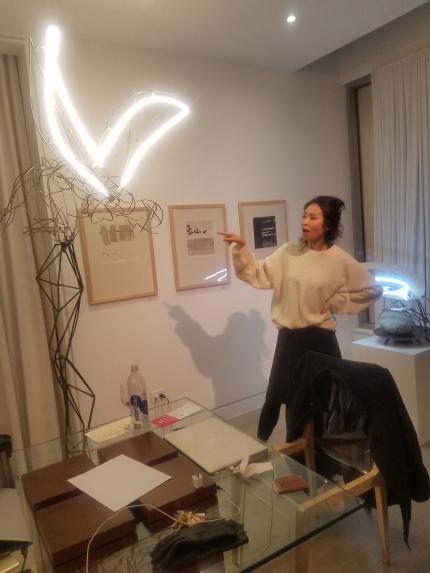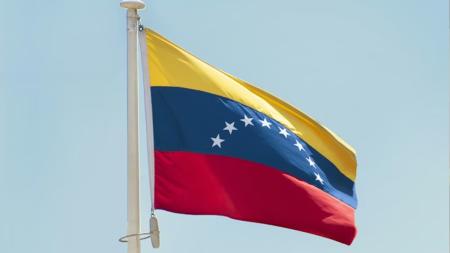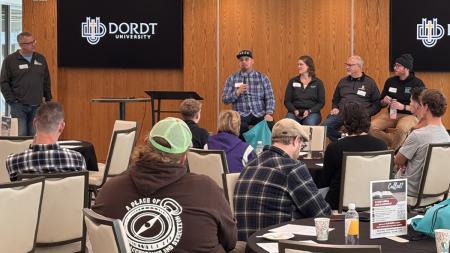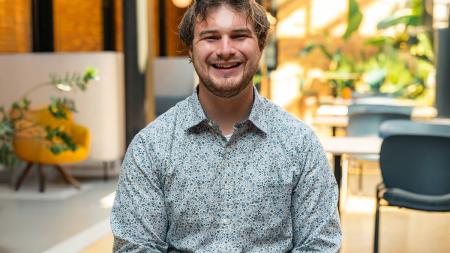Finding the Lydias in New York City

Kate Shin discuss the illuminated image, which looks like angel wings.
I was recently in New York City with members of Resonate Global Mission’s new Mission Innovation Team (MIT), who had gathered to discuss plans for the future as well as to visit different sites and ministries in New York City.
We met at City Seminary in Harlem and from there went to several ministry locations, especially for prayer and yet also to see different ways is which ministry is happening in the largest city of the United States.
Moses Chung, former director of Christian Reformed Home Missions, invited me along because he and I are working on a project that charts how the work of Home Missions evolved and grew over the past 20 years before the 2017 unification with Christian Reformed World Missions.
“We came to New York to pray but also to meet as a team and to see some of the ways people are living out their faith in fresh, Spirit-led ways,” said Chung, now the director of mission innovation for Resonate.
Also at the MIT meeting was Joel Huyser, who served with World Missions for many years and is now Resonate’s global area director for Latin America and Asia.
Though he traveled widely as a leader for World Missions, Huyser had never been to New York City before.
“I had the idea that New York was a very post-Christian place,” he said.
“What surprised me was to discover the amazing ways God is already at work in this city — through a hedge fund broker who hosts a weekly group that just gathers to listen to Scripture in the New York Times building, through an Asian-American woman who hosts a prayer group for artists in her art gallery, and through a non-traditional seminary that is serving the vibrant presence of the global church throughout the city.”
Huyser said it seemed the MIT group was a bit like Paul and his companions in Acts 16 as the Spirit led them to bring the gospel to Macedonia, where he met Lydia and others in the city of Philippi.
Lydia was a successful businesswoman who was a Gentile believer in the God of the Hebrew Scriptures and responded quickly when Paul told her the good news of Jesus.
Sorting through the experiences and fascinating encounters we had in New York, I really appreciated being on hand as the MIT met at City Seminary, a school that serves pastors, church leaders, and others, many from foreign cultures and countries, who live in one of the city’s five boroughs.
But what especially sticks in my mind was the way prayer was a crucial part of this trip. We had a chance one day to join with seminary workers at noon for their weekly prayer session.
Branching Out for Prayer
Early one morning, we traveled for a weekly prayer gathering at the Waterfall, an Upper East Side art gallery operated by Kate Shin, an exuberant woman whom many on the innovation team compared to Lydia when they heard her story.
But before hearing her story later that day, we all prayed and then, unexpectedly at one point, regular attenders, many of them artists, invited us visitors to stand in a circle as they laid hands on us and prayed for the success of Resonate as it moves forward.
In some ways, said MIT members later, it was like a send-off for this new mission agency as it makes its way in the world.
“Lord,” said one person, “please keep them and hold them and help them. They are doing your work, Lord, and, please, Lord, let your Spirit guide them and show them how to do the ministry for the church. Let them have strong faith in a world that is strong with unbelief.”
Even as I had my head bowed and eyes closed, that comment about an unbelieving world made me think of another prayer gathering from the night before, which was followed by a presentation by researcher George Barna.
A Sobering Picture
Sponsored by Concerts of Prayer of Greater New York, we went the day before to a conference center in Tarrytown, just outside New York City, to attend the annual Pastor’s Prayer Summit. We were on hand for an evening session.
Pastors from all over the area and from different denominations were there to pray, worship, and listen to speakers. Partway through the evening, as others from MIT, tired from a long day, headed back to Harlem, I stayed to hear Barna.
As a long-time religion writer, I have often run into Barna’s work as a researcher on the intersection of faith and culture and wanted to hear what he had to say.
I’m glad I stayed, and yet it was sobering to hear him talk about his latest research on the state of religious belief in America, based on data that his organization, the American Culture and Faith Institute, gathered in early summer 2017.
“Only one in 25 millennials, those men and women of parenting age, have a biblical worldview. And these are the parents who will determine what their children will believe in the future,” said Barna after describing this worldview as one that holds to a fairly literal reading of the Bible.
According to the data, Barna said, “core Christian beliefs are eroding” in the U.S.
Other statistics: only one in four people in the U.S. believe in the Holy Spirit, about one in three people say the Bible is totally accurate, and nearly 60 percent say that there is no such thing as moral truth.
While much of what he said was troubling, one of the final statistics was thought provoking and perhaps helpful to groups such as MIT trying to find ways to help bring people to deeper faith.
Some 75 percent of the population, said Barna, are seeking and trying to find ways to lead a more meaningful life.
“This is not the time for you to think how you can do more good works,” he told the pastors gathered at the summit. “It’s time for you to rethink how we approach today’s culture.”
Meeting Lydia
A few hours after leaving the morning prayer at the Waterfall Gallery, we returned to eat with and learn from Kate Shin, who shared how she came to find deeper meaning in her own life.
She told us how she had been a successful real-estate developer and that one of her projects was to convert a downtown Manhattan mansion — now the Waterfall — into an art gallery.
It was hard work, she said, and she had planned to sell the gallery for upwards of $30 million and move on to another real-estate deal.
But on the night several years ago when she held a reception to show the place to potential buyers, she looked around at all of the people and realized just how awful she felt, how empty she was — and, looking to her future, she didn’t feel optimistic.
She was missing something and didn’t really know what it was until a young artist named David Chang approached her and, almost in an embarrassed manner, said he had received an urging, a message on his heart from God.
“He told me that God wanted to bless me but that I needed more prayer,” said Shin. “He asked me if I prayed regularly, and I told him I didn’t. The next Wednesday he came to pray with me, and that is how things started.”
In light of what is said about Lydia in Acts 16, members of MIT commented that Shin’s meeting and praying with Chang was her Lydia moment; it was when she felt God open her heart and started to fill it with a hope she hadn’t had in many years.
Today Chang is one of the partners in the art gallery, which she considers a ministry. She displays art from around the world from artists of many religions or no faith at all, working patiently with them, helping them in their struggles, and offering, when they seem ready, the chance to learn more about and to embrace Christianity.
And often, with Kate Shin as a guide, the work of these artists changes from something dark to something filled with light, allowing them to share the good news through art.
“This is a place where artists can walk in and discover God and that their art can represent God,” said Shin.
Listening to the Bible
MIT members began their last day in New York City by taking part in what is called a Communal Reading of Scripture in a conference room at Archegos Capital Management on one of the upper floors of the New York Times building near Times Square.
Bill Hwang, founder and chief executive officer of Archegos, is the developer of the project, in which people gather to hear Scripture and, as they listen, can read it from a large screen.
Hwang began the effort a few years ago after he faced difficulties in his work and turned to the Bible to strengthen his faith. Because he wasn’t an avid reader, though, he found that listening to an audio version helped to get him back on track.
“Listening to God is a very substantive posture, and it reminds us of who listens to us the most — God,” said Hwang. “If you listen to the Bible for one or two hours every day, you can finish it in a year. And it is a pleasure to listen to our Father together with other people.”
With the skyline of New York spreading out beyond the windows, we listened to a reading from Exodus 7, 8, and 9 recounting the plagues God visited on the Egyptians before Pharaoh released the Israelites from slavery.
I found that by listening to Scripture this way, aspects of it became clearer; it struck me how much God had to do to get the hard-headed Pharaoh to relent. I appreciated taking it in, letting it settle, and not needing to examine what it all meant. The process was more like prayer than a study.
Charles Kim, team leader for diversity for Resonate, had suggested that MIT meet in New York City to learn more about City Seminary and to meet people such as Kate Shin and Bill Hwang and to sit high up in the New York Times building listening to Scripture.
“It was good to go to New York to connect with friends whom I knew were very active in following Christ through their vocations in the major metropolitan area,” he said. “They are part of missional communities that are doing unique and creative ministry where we can learn and possibly partner for missions to the city.”
In fact, Kim has already joined with Hwang’s Grace and Mercy Foundation and its Just Show Up program to help bring the Communal Reading of Scripture to CRC congregations. So far, several CR churches are involved.
“Just Show Up initiatives are great and practical ways to form learning communities,” said Kim.
We ended our time together back at City Seminary with more prayer and communion. MIT members then left for home with a good start on planning their future.
As for me, I returned to West Michigan with greater insight into how Resonate can help bring the good news of Christ to and learn from the Lydias of this world.


